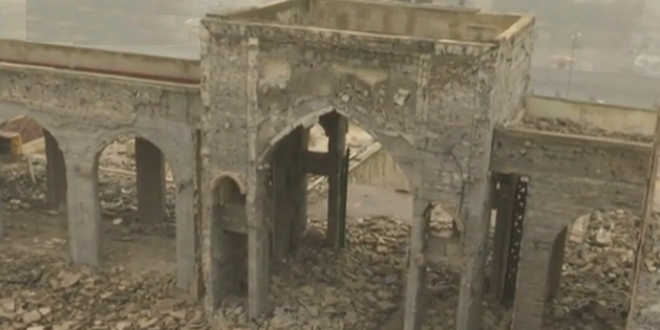The palace of the Biblical King Sennacherib, long buried underneath the tomb of the prophet Jonah in the Biblical city of Nineveh, has incredibly been discovered by Iraqi archaeologists as a result of efforts by the Islamic State (ISIS) to destroy the site and loot its priceless antiquities.
The shrine is, according to tradition, built on the burial site of Jonah, known as Nabi Yunis in the Koran. Located in the northern Iraqi city of Mosul, the structure was destroyed by ISIS in July 2014. When the city was liberated by Iraqi troops a few weeks ago, archaeologist were dismayed to find that not only had ISIS used dynamite to destroy the shrine, but the terror group had tunneled underneath and carried away hundreds of artifacts to sell on the black market.
However, the tunnels revealed a completely unexpected treasure: the 2,300-year-old palace of King Sennacherib, mentioned in the Bible. During Sennacherib‘s reign, Nineveh was one of the richest cities in the world. His military campaign against the Kingdom of Judah is described in the Bible.
After these things, and this faithfulness, Sancheriv king of Ashur came, and entered into Yehudah, and encamped against the fortified cities, and thought to make a breach therein for himself. II Chronicles 32:1
The palace, built by Sennacherib, who ruled Assyria from 705 BCE to 681 BCE, was later expanded by his son, Esarhaddon (681-669 BC). The palace was partly destroyed during the Sack of Nineveh in 612 BCE.
Archaeologists are working desperately to save whatever they can, as the tunnels are unstable.
“I can only imagine how much Daesh (ISIS) discovered down there before we got here,” Iraqi archaeologist Layla Salih, who is supervising the team carrying out the emergency exploration, told the Telegraph. “We believe they took many of the artifacts, such as pottery and smaller pieces, away to sell. But what they left will be studied and will add a lot to our knowledge of the period.”
The destructive efforts did bring some benefit to archaeologists. The site was largely unexplored, and though two previous efforts at excavation were carried out, the most recently in the 1950s, archaeologists had never reached as far as the palace.
“The objects don’t match descriptions of what we thought was down there, so [ISIS’s] destruction has actually led us to a fantastic find,” Salih said.
Archaeologists have discovered in the palace a rare cuneiform slab they believe was made during Sennacherib’s reign.
In another part of the tunnel they discovered Assyrian stone sculptures of an Assyrian demi-goddess, depicted sprinkling the “water of life” to protect humans in her care.
“There’s a huge amount of history down there, not just ornamental stones,” Salih said. “It is an opportunity to finally map the treasure-house of the world’s first great empire, from the period of its greatest success.”
After ISIS destroyed the structure, archaeologists discovered the Muslim shrine had been built on the ruins of a church, originally called The Monastery of Jonah, dating back from the fourth century Christian Syriac denomination. According to tradition, the church contained a piece of Noah’s Ark. The Shrine of Jonah was closed to Christians in 1902.
It is unclear why ISIS destroyed the mosque of a prophet venerated by Islam. It is believed that ISIS, as part of the Salafi movement, rejects the concept of worshipping at shrines and therefore destroyed it to prevent Muslims from worshipping there. Some have speculated that the destruction of the site was intended to wipe out vestiges of Christianity and Judaism, even those connected to Islam.
Even within Islam, the site is not universally accepted as the Biblical prophet’s burial place. In the Jewish tradition, Jonah returned to his hometown of Gath-Hepher in the Galilee after his mission to Nineveh and was buried there. Another Islamic shrine in Halhul near Hebron is claimed by the Muslims to be the Jewish prophet’s burial site.
The post ISIS Destruction of Jonah’s Tomb Incredibly Reveals Ancient Palace of Biblical King Sennacherib appeared first on Breaking Israel News | Latest News. Biblical Perspective..
Source: Israel in the News


